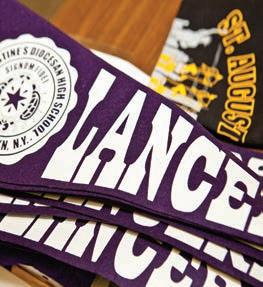
19 minute read
Class Notes ı St. Augustine
BISHOP LOUGHLIN
con’t
Augie Catalano ‘73 is alive and well living in the Pacifi c Northwest.
Kevin Bolger ‘75 retired in March after 36 years of service with the U.S. Environmental Protection Agency. He and his wife Debbie are staying in the Chicago area to be close to their children and grandchild. As soon as it is safe again, they plan to travel within the U.S., Canada, and Europe.
Gary Maxwell ’80 reports “it only took 40 years and a pandemic to bring two best friends from high school together again! Three days after graduation, I ventured off to the Air Force. But before departing, I assured my best friend Kenny F. we’d stay in touch. Needless to say, back in the day, there was no email, texting, or video-chat capability. Thus, life got in the way of our keeping in touch. Over those decades (hard to imagine time going so fast), I’d think about him every so often and wonder how he was doing. As it turns out, he was doing the same. While he didn’t venture very far from his New York roots, I began a world-wide adventure. I spent 30 years in the military with countless adventures. It was a chance FaceBook post of his that reunited our friendship. However, before he would give me the time of day to catch up, he asked one question... what was ‘our’ hobby at Bishop Loughlin. I laughed! Needless to say, we are on track again!”
Joseph Kisinski ‘81 says “this year has not been a very good one. My best friend from fi rst grade contracted the coronavirus, was hospitalized, in a nursing home, and fi nally was able to go home. On January 11, 2020 my mom passed away from congestive heart failure; she was 83.” ◊
STAY IN TOUCH...
contact us with your updated information or share noteworthy accomplishments and/or events! Submit news to Morgan Allison @ mallison@blmhs.org.
ST. AUGUSTINE HIGH SCHOOL ST. AUGUSTINE HIGH SCHOOL
Paul Napoleon Moscatt ‘49 is a retired Art Professor. “I have been teaching plein-air sessions and painting with participants — fortunate to have an available pleasant garden to conduct these sessions. I am also assisting my daughter in conducting the fourth Baltimore Next Media Webfest, 2020. Elena Moscatt originated and has produced this webfest which has submissions nationwide and from 22 countries. This year the webfest is free and online (bnmwebfest.com).”
Thomas E. Olszewski ‘54 has been a volunteer for the Franciscan Sisters of Holy Eucharist in Meriden, CT and at the Holy Apostle College and Seminary in Cromwell, CT for 11 years. “Married 51 years, I lost my wife ten years ago. I have six children; one died 20 years ago. I have ten grandchildren and one great-grandson. Last year, I received the spiritual service award from Bishop Cody and Father Mosey. A big hello to my 1954 classmates.”
Paul Gale ‘55 is living well in Atlanta, GA.
William P. Kinane ‘59 lives in Novato, California in Martin County (just north of San Francisco) and spends a signifi cant part of the year in Sunriver, Oregon. “I have been married for more than 50 years and have three children and four grandchildren.”
Ernie Villany ‘63 and his wife have relocated to Knoxville, TN to be closer to their daughter after 75 years in the New York area. “Come February she will be having my fi fth grandson. A real blessing.”
John Ross ‘64 is doing well in Virginia Beach, retired from the Army after 28 years. “Virginia Beach is kind of like Breezy Point but summer almost all year long. I have three healthy children — all married, and seven grandkids. Hope all are doing well and would love updates.”
Michael O’Kane ‘66 relocated to Venice, Florida two years ago. “I hope my classmates are well and living the dream. Constant memories of Park Place. A special place and time. Hello John Loosen, Walter Kelly, and Tom Brown.”
Michael P. Cangemi, CPA ‘66 writes “My thoughtful thanks to the Christian Brothers and staff of St. Augustine HS for a great foundation, morally and intellectually. Try to always be patient and nurturing to your students who lack engagement, especially those who do not have the benefi t of adequate family guidance. My engagement began late with an economics class as a Junior, when at the same time a classmate brought the opportunity for a part-time job at Merrill Lynch on Wall Street. At graduation, I was listed as ‘not attending’ college, since my plan was to have success on Wall Street. With divine intervention, I did start college in September after graduation, while continuing to work part-time on Wall Street. This led to a fantastic career and a wonderful bountiful life. Thank You, Christian Brothers!”
Gary F. Hansen ‘68 recalls “The year was 1966. I was a sophomore at St. Augustine HS when the Transport Workers Union and the Amalgamated Transit Union called a strike in NYC. This caused a shutdown of all subways and bus routes in the city. As a student, I was left on my own to fi nd transportation to school. St. Augustine tried at fi rst to hold classes but attendance was minimal and sporadic. A call-in program was developed, with time limits on turning in your assignments. Even then you had to fi nd a way to the school. Taxis were allowed to carry more than one passenger, but that was expensive. Thumbing A RIDE WAS YOUR BEST OPTION AS LONG AS THEY WERE GOING IN YOUR DIRECTION! This caused numerous
problems for Mayor Lindsay since traffi c was already at a standstill. Eventually the strike was settled and Mike Quill, head of the strikers union, was jailed and died weeks later. The strike led to the passage of the Taylor Law but for a young kid it was an unforgettable experience.”
Louis P. Valentino ‘69 reports “All is well with me! Lou G., Stephen, and I have kept in touch meeting for lunch at L&B from time to time.”
Ed Stack ’69 is enjoying retirement and spending time with his three grandchildren, ages two, three, and fi ve. “Our second home outside Hilton Head, SC has provided a much needed refuge in this pandemic year. Really enjoyed seeing my St. Augustine classmates at last year’s 50th anniversary celebration. I am looking forward to reconnecting in 2021 when we get this coronavirus behind us. St. John Baptist De La Salle, pray for us. Live Jesus in our hearts. Forever.”
Stephen Giordano ‘69 lives in Easton, PA with his wife of 41 years, Rosemarie. “I am still working though on disability from having a kidney transplant (Rosemarie was my living donor). The original 1969 class reunion committee met this past January to open discussions for future alumni gatherings. Two suggestions were tabled: an alumni dinner and possibly a long weekend getaway, including alumni guests. The pandemic outbreak has put on pause any future in-person gatherings. Several of us have met at Brooklyn’s Spumoni Gardens (still the place to go) — Lou Gambino, Tom Monahan, Lou Valentino, Jack Occhigrosso, and Vinny Passion, from the class of 1968. Rich Faga and Dough DeFaux have reached out to the committee to assist in coordinating a virtual video session. Forty alumni have accepted the invitation (details are being worked on). We are waiting to hear back from 35 alumni. If anyone has questions or suggestions, my contact email is stephengiordano@hotmail. com and my phone number is 484-5442009.” ◊
LANCERS:

THE BROTHERS BOYS, WHO ARE THEY?
by Ed Smith ‘62 M Squad Chief (Brother A. Peter Walsh, Moderator) Retired Partner ı Peat, Marwick, Mitchell ı Retired Major USMC ı Adjunct Professor, St. John’s University ı Husband, father — soon to be grandfather Forever Lancer and Brothers Boy

They came from all corners of Brooklyn — Flatbush, Bay Ridge, Park Slope, Sheepshead Bay, Coney Island, Gravesend, Bensonhurst, Boro Park, Sunset Park, Fort Hamilton, Crown Heights, Flatlands, Marine Park, Brooklyn Heights, Clinton Hill, South Brooklyn, and Red Hook. No, not a recent class of draftees lined up at the Whitehall Street induction center but students at St. Augustine Diocesan High School at 64 Park Place in Park Slope. They were Lancers, after the school mascot a knight on a horse, who were embarking on a life changing adventure.
The school has a storied history and holds a sweet spot in the hearts of the boys who attended. “The Brothers Boys”, so called because of the Christian Brothers who conducted the school for nearly 60 years until it closed in 1969. We were drawn to Augustine, or rather in many cases directed to attend, by our parents since the school was relatively tuition-free. Today, there are no regrets about that decision.
St. Augustine began as a parish high school for St. Augustine’s Roman Catholic Church on Sixth Avenue and Sterling Place. You will all recall that in those days Brooklyn was known as the “Borough of Churches”. Seemed the number of churches were only exceeded by the number of “gin mills” in the neighborhoods of Brooklyn.
For all of us, growing up in Brooklyn in the 50s and 60s was an experience like no other. We had the Brooklyn Eagle, the Brooklyn Dodgers, The Brooklyn Navy Yard, Todd Shipyard, the docks and their longshoreman, The Rheingold Brewery, Domino Sugar Plant, White Rock Beverage, and many other factories and industrial facilities.
Brooklyn was home to numerous immigrant groups and each neighborhood bore distinct ethnic personalities, as did their churches. We had our shared Brooklyn accent and a strong sense of who we were. Lancers had no fear. They roamed New York as if we owned it. We were the sons of many WW II veterans, growing up in simpler times as America boomed after the war. Television was our high tech. Everyone can recall Brooklyn’s unique character. We all remember how it was common to ask someone; “what parish are you from?” as a way of fi xing their neighborhood and who they were. For many of us, we continue to do this when we meet someone with Brooklyn roots.
In 1909, the Brothers of Christian Schools began running St. Augustine at the request of the Brooklyn Diocese’s Archbishop Molloy. The Brothers, an order of teachers, were founded by St. John Baptist De La Salle in France. Bishop John Loughlin, Brooklyn’s fi rst Bishop, invited the Brothers to conduct a school for boys in Brooklyn. Initially they set up in St. James (later renamed Bishop Loughlin Memorial High School). Bishop Loughlin led an initiative to educate the children of immigrants and wanted to instill a strong culture of faith, morals, hard work, and citizenship to ensure that his fl ock assimilated and contributed to life in America. Today, we can report “mission accomplished”. immigrant destination. No one would consider themselves rich or poor. We were all close in economic status. Families that owned their own homes might have been considered better off . Our families were primarily working class, laborers, cops, fi remen, teachers, a few professionals, and a few had college grads as a parent. Our ethnic heritage was often on display in cafeteria as we brought our lunch from home. Variety was not necessarily a quality of our own individual lunch so we often shared or traded lunches to get a new taste. Although, the Italian guys always seemed to have the most in-demand lunches.
As we arrived at St. Augustine’s, more daunting than meeting new classmates was But what of St. meeting the Brothers Augustine and St. Augustine’s Class of 1962 members Jim McHugh, John Clarke, Carl Crownover, and Ed Smith. for the fi rst time. For the Brothers Boys? many of us who were Unfortunately with the school’s closing in 1969, the pipeline for taught by nuns in grammar school, meeting an all-male faculty new Lancer alumni ceased. Our alumni are spread principally led by the Brothers was not easy for a prepubescent freshman. throughout the northeast but in many other parts of the United We were fi lled with awe, wonder, and fear. Many of the Brothers States. I can even report that in 1981 while in Japan, I met an boasted of their experience at Lincoln Hall, we supposed a type alum who lived in Tokyo — Murphy was his name. Apparently, he of reform school that the Brothers operated. was part of the occupation forces and never left.


Lancers have distinguished themselves in public service, education, science, arts, legal, law enforcement, fi re prevention, and business. Sports were also a key part of the education curriculum, albeit mainly basketball and track. A few times in its history Augustine boasted baseball and swimming as varsity sports. Several Lancers entered the religious life as priests or brothers. Lancers can count in their ranks a former governor of New York State, university presidents, lawyers, judges, a former New Jersey Nets guard, a Chaplin for the Mets, and U.S. military academy graduates — who held all ranks in the Army, Navy, Marine Corps, Air Force, and Coast Guard. There have been many veterans of world wars, Korea, and Vietnam. One Lancer is a surviving Vietnam war POW. Each of us are proof that we learned our lessons well and lived up to the Brothers’ expectations and Bishop Loughlin’s plan.

But what of these men — who are they, what did the learn, what do they think, how have they lived life?

We can look at the class of 1962 (my class) and others in the 60s as Augustine neared its fi nal gradation in 1969. The students came to Augustine from varied family backgrounds and ethnicities, truly a microcosm of New York’s melting pot and Students had to adjust to this male environment and changing classrooms on a precise schedule with diff erent teachers and personalities. This required personal discipline and adjustment. Once you managed this, it was liberating to experience that freedom of movement and individual responsibility coupled with the chaos and banter of the hallways and stairs as all four grades hustled about. There were around 400 students at Augustine, and it seemed you knew them all.
We all remember Brother Azarias Peter (Walsh), a ruddy Irishman with calloused hands who could have easily passed for a longshoreman. He was referred to as Brother Willie or Wille Peter, always out of ear shot, because of his habit to call someone Willie to catch their attention, usually for doing something that required attention, or he disapproved of. I recall in early 2000 visiting Brother at LaSalle Hall in Lincroft, New Jersey and thanking him for what the Brothers and St. Augustine had done for me — the education, guidance, and growth. Brother Peter wanted no credit, instead he kept telling me to thank my parents for having the foresight to send me to St. Augustine.
Our class began with about 170 students and fi nished with 130. We continue to meet, tell many of the same stories, and just enjoy the friendship forged nearly sixty years ago. There is a









remarkable bond between us that was molded and nourished by the Brothers and our personal moral core which the Brothers helped nourish. Many Lancers use the same expressions to describe their time at St. Augustine: disciplined, formative, lifechanging, enriching, good fun, morally and spiritually uplifting, interesting, stimulating, civic minded, and satisfying memories and fondness for fellow students and Brothers. But most of all, it is always about the Brothers and the guys — and the personal bond with each other and the Brothers. This grip is hard to explain, except to a fellow Lancer.







When you read the bios for many in our class, giving back is a common theme. Many have developed a strong sense of civic responsibility and have served on boards for charities and nonprofi t health and welfare institutions or volunteered at many of these institutions and in their churches. Many of us continue to volunteer even at this stage in our lives.

But then what was it like inside the school? Days seemed long but managed to go by quickly, especially if you engaged in after school activities. Unfortunately, for a few, this was not always possible as some had to help at home with a family business or hold down a part time job.
As one alum put it, we were taught to be good and honest men. Not to say we did not have time to be boys. One thing the Brothers practiced was to give us rope and room to run, jump, and play — while not holding the reigns tightly. You can only imagine the horse play going on in an all-boys school in the 60s, all good fun and never any bullying. We enjoyed each other — the interaction, the ribbing, and the competition. We had each other’s back. Never let a Loughlinite, or Prep-Guy, be it Brooklyn, St. John’s, or St. Francis pick on a Lancer because we were all there. We were all thankful for the freedom and guidance. The Brothers helped create a sense of security that let us know we were amongst friends and that the Brothers were always there, watching and guiding us. This was essentially covert as you often did not see them but felt their presence.
We may not have realized or appreciated all this at the time, its mainly now when we are older and leading the lives of solid citizens, good Catholic men, husbands and fathers, or even grandfathers, do we realize and appreciate what we had at St. Augustine and the gift the Brothers gave us, including their gift of time and their lives.
At a 1962 class dinner at Circles Restaurant in Windsor Terrace, Brooklyn (Holy Name Parish if you must ask), we recall Brother Jerome (Corrigan) making a few remarks about St. Augustine’s and his time there as Assistant Principal and basketball coach. He thanked us for being who we are, continuing to get together, and including him. He was having a good time. He said that seeing us and enjoying our company as men helped “validate his life”. A remarkable statement that created a “grace fi lled moment”. Another such moment came at the fi rst combined Augustine reunion held at Bishop Loughlin in November 2001, not long after We were taught to be good and honest men. Not to say we did not honest men. Not to say we did not have time to be boys. One thing have time to be boys. One thing the Brothers practiced was to give the Brothers practiced was to give us rope and room to run, jump, us rope and room to run, jump, and play — while not holding the and play — while not holding the reigns tightly.
9-11. Seeing the large group of guys, remembering our school 9-11. Seeing the large group of guys, remembering our school and classmates, feeling the sadness of 9-11 and participating in and classmates, feeling the sadness of 9-11 and participating in a mass con-celebrated by twelve priests — all graduates of St. a mass con-celebrated by twelve priests — all graduates of St. Augustine — was very moving. It made me proud to be a Lancer, Augustine — was very moving. It made me proud to be a Lancer, a Catholic and in Brooklyn. It felt right, and was grace fi lled. I could feel the warmth, friendship, and God’s presence. It was such a wonderful afternoon and evening that none wanted to go home.
We are thankful for the opportunity and blessings of those four years. The experience had a great deal to do with who we are, what we believe and how we live our lives.
We share the memories of basketball games at the old Madison Square Garden on Eighth Avenue, Field Days at Red Hook Stadium, bowling at the Union Street bowling alley, track meets at Van Cortland Park, practices at the Bedford Avenue Armory, intramural softball games at the 4th avenue park with only black top for a playing fi eld, the intramural basketball games in the basement gym where a jump shot had as good a chance of hitting the ceiling as it did the rim, commuting to school by train or bus with a small band of school mates, the annual Rye Beach Boat Rides with “our sister school” Catherine McAuley HS, the “Tea” dances in the afternoon in our auditorium, parish dances throughout the diocese, and even a plane crash on Seventh Avenue that narrowly missed the school. All the things that made being a teenager growing up in Brooklyn in the 60s memorable.
The depth of feeling of the shared experiences and memories uniquely and entirely Catholic, help explain the unbreakable hold that St. Augustine has on this group of men, Lancers and Brothers’ Boys all.
One such experience is daily prayer, we can all in almost perfect unison still recall those that started and ended our days and made a Christin Brother school a Christina Brother School: St. John Baptist de la Salle. (yes, you supply the answer) Live Jesus in Our hearts. (one more time guys)
God bless my fellow Lancers; it has been my honor and pleasure to share this refl ection with you. ◊









